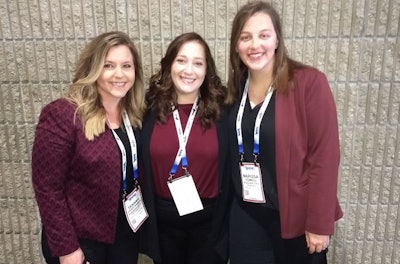
We have addressed before how there are more jobs in the agrifood industry than there are people who are qualified to fill them. This is particularly true of the poultry industry.
But after attending the International Poultry Scientific Forum, held in conjunction with the 2022 International Production & Processing Expo (IPPE), I can feel confident that at least one university is doing what it can to fill that gap.
During the “Teaching, Pedagogy, Extension” session at the forum, I was compelled by what Mississippi State University (MSU) poultry science graduate students Peyton Taylor and Marissa Powell had to say, as well as MSU poultry science coordinator Tannah Christensen.
Recruitment and retention of students
Taylor presented on an assessment of retention trends in MSU’s College of Agriculture and Life Sciences (CALS), to determine possible internal recruitment efforts for poultry science departments.
Noting that there is a strong demand in the workforce for graduates of poultry science programs, and that the majority of college students will change their major at least once before earning a degree, looking for poultry science majors among students already on campus can be a worthwhile endeavor. Taylor noted that off-campus recruitment efforts, while still necessary, can use a lot more resources than on-campus recruitment.
Earlier research showed that animal science and biochemistry programs often have some of the lowest retention rates among CALS programs, and Taylor said this would be a prime target area to recruit poultry science majors.
Taylor and others conducting the study reached out to both CALS students and advisors at universities with a poultry science department, and they got responses from 584 students and 110 advisors.
The study showed that 63% of the student respondents did not know they could major in poultry science, even though such a program was offered at their university, and 84% initially did not plan to take poultry courses.
But after receiving information on jobs in the poultry industry, the impact of poultry on the economy, job placement and starting salaries, 77% said they would be interested in taking a poultry science course and 23% said they would be interested in a major in poultry science. While Taylor said 23% might not sound like a high number, she pointed out that would equate to more than 100 additional poultry science majors.
Hatch-Out program
When it comes to finding future poultry science students, MSU hasn’t stopped at those already in or about to enter college. It is also helping educate those who are much younger.
MSU has implemented what it calls the Hatch-Out program, an agriculture education program brought to classrooms for students at the K-12 levels. Powell told of that program and its applications for kindergarten, first grade and second grade.
This program is unique, Powell said, in that any teacher – regardless of their background – can implement it into his or her classroom. This program allows MSU to introduce the poultry industry to students with a curriculum and lesson plan.
“We believe that a positive agriculture experience and curriculum can benefit the industry, as well as benefit students by allowing them to be educated on specific topics,” Powell said.
Such agriculture education programs are important, Powell said, and introducing the poultry industry to kids at an early age can have an impact that can follow them into adulthood, whether it introduces them into possible careers, or gives them knowledge they can apply as consumers.
The Hatch-Out program originated in a pre-pandemic era, but once COVID-19 had a huge impact on how students become educated, the need for a hybrid-online Hatch-Out program became necessary, said Christensen.
With a hybrid-online program available, more students can be reached, she said.
The hybrid-online program was introduced in two elementary schools with 26 teachers and 529 students.
Christensen reported that as they surveyed the teachers, the program not only taught the students more about the poultry industry, but also the teachers themselves. Prior to using the program, only 44% of the teachers rated their knowledge of poultry as “average,” while after using the program, 72% said they felt they had a “good” knowledge of poultry.
What is your university doing?
I can’t help but think if all universities with poultry science programs were taking steps similar to MSU, there would be less of a personnel shortage.
Maybe they already are. And if so, I would love to hear about it.
While we at WATT Global Media do our best to inform our readers about what is being done at the university level to prepare the next generation of poultry industry leaders, I hope we can do more of this in the future. If you, like the people from MSU, are taking extra steps to close this deficit, please inform me.


















